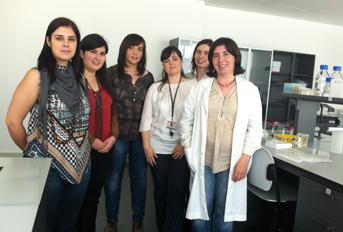Associação Portuguesa de Investigação em Cancro
Flavonoids impair glucose uptake and metabolism by breast cancer cells
Flavonoids impair glucose uptake and metabolism by breast cancer cells

A research group from the Department of Biochemistry of the Faculty of Medicine of University of Porto, the Chemistry Investigation Centre and the Faculty of Nutrition and Food Sciences of University of Porto, has demonstrated that two green tea flavonoids, quercetin and epigallocatechin gallate, act as metabolic antagonists in breast cancer cells.
In MCF7 breast cancer cell line, the researchers demonstrated that these two flavonoids impair the cellular uptake and metabolism of glucose, the main source of energy for tumor cells crucial for cell survival and proliferation. This impairment was shown to be independent of estrogen signaling, and additionally it was shown to impact negatively on tumor cell survival and proliferation.
These results suggest that quercetin and epigallocatechin gallate could serve as therapeutic agents/adjuvants for breast cancer.
Authors and affiliations:
Liliana Moreira (1), Isabel Araújo (1), Tito Costa (1), Ana Correia-Branco (1), Ana Faria (1, 2, 3), Fátima Martel (1) and Elisa Keating (1*)
(1) Departmento de Bioquímica, Faculdade de Medicina da Universidade do Porto, Alameda Prof. Hernâni Monteiro, 4200-319 Porto, Portugal
(2) Centro de Investigação em Química, Faculdade de Ciências da Universidade do Porto, Rua Campo Alegre, 4169-007 Porto, Portugal
(3) Faculdade de Ciências da Nutrição e Alimentação da Universidade do Porto, Rua Dr. Roberto Frias, 4200-465 Porto, Portugal
Abstract:
In this study we characterized 3H-2-deoxy-D-glucose (3H-DG) uptake by the estrogen receptor (ER)-positive MCF7 and the ER-negative MDA-MB-231 human breast cancer cell lines and investigated the effect of quercetin (QUE) and epigallocatechin gallate (EGCG) upon 3H-DG uptake, glucose metabolism and cell viability and proliferation.
In both MCF7 and MDA-MB-231 cells 3H-DG uptake was a) time-dependent, b) saturable with similar capacity (Vmax) and affinity (Km), c) potently inhibited by cytochalasin B, an inhibitor of the facilitative glucose transporters (GLUT), d) sodium-independent and e) slightly insulin-stimulated. This suggests that 3H-DG uptake by both cell types is mediated by members of the GLUT family, including the insulin-responsive GLUT4 or GLUT12, while being independent of the sodium-dependent glucose transporter (SGLT1).
QUE and EGCG markedly and concentration-dependently inhibited 3H-DG uptake by MCF7 and by MDA-MB-231 cells, and both compounds blocked lactate production by MCF7 cells. Additionally, a 4h-treatment with QUE or EGCG decreased MCF7 cell viability and proliferation, an effect that was more potent when glucose was available in the extracellular medium.
Our results implicate QUE and EGCG as metabolic antagonists in breast cancer cells, independently of estrogen signalling, and suggest that these flavonoids could serve as therapeutic agents/adjuvants even for ER-negative breast tumors.
Journal:
Experimental Cell Research
Link:
http://www.sciencedirect.com/science/article/pii/S001448271300195X




